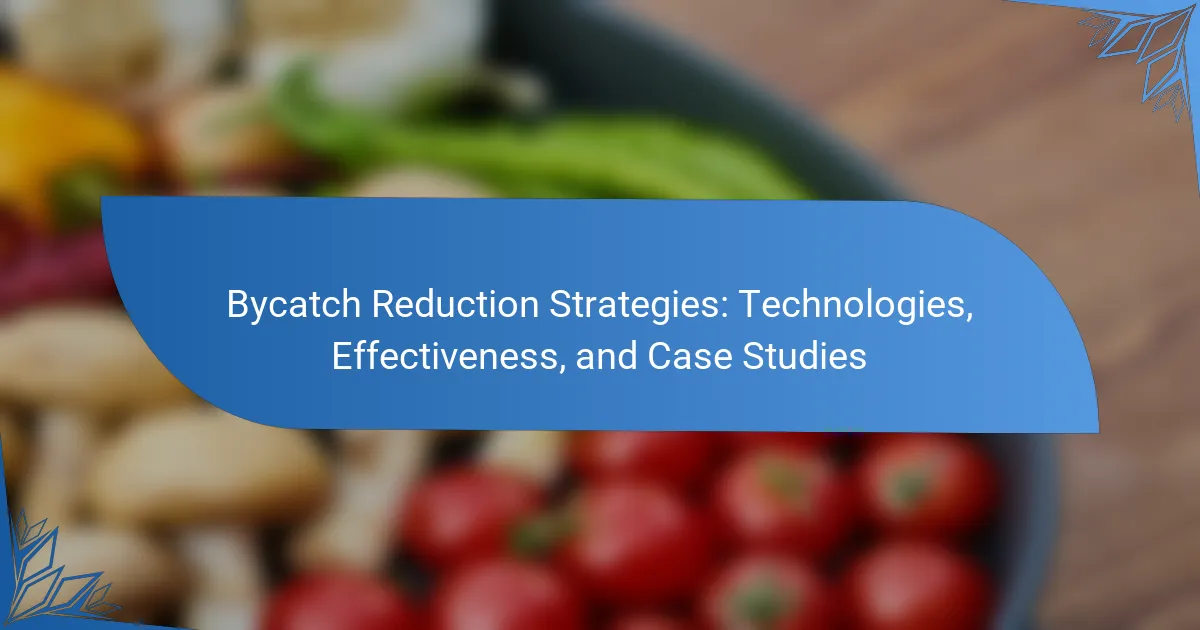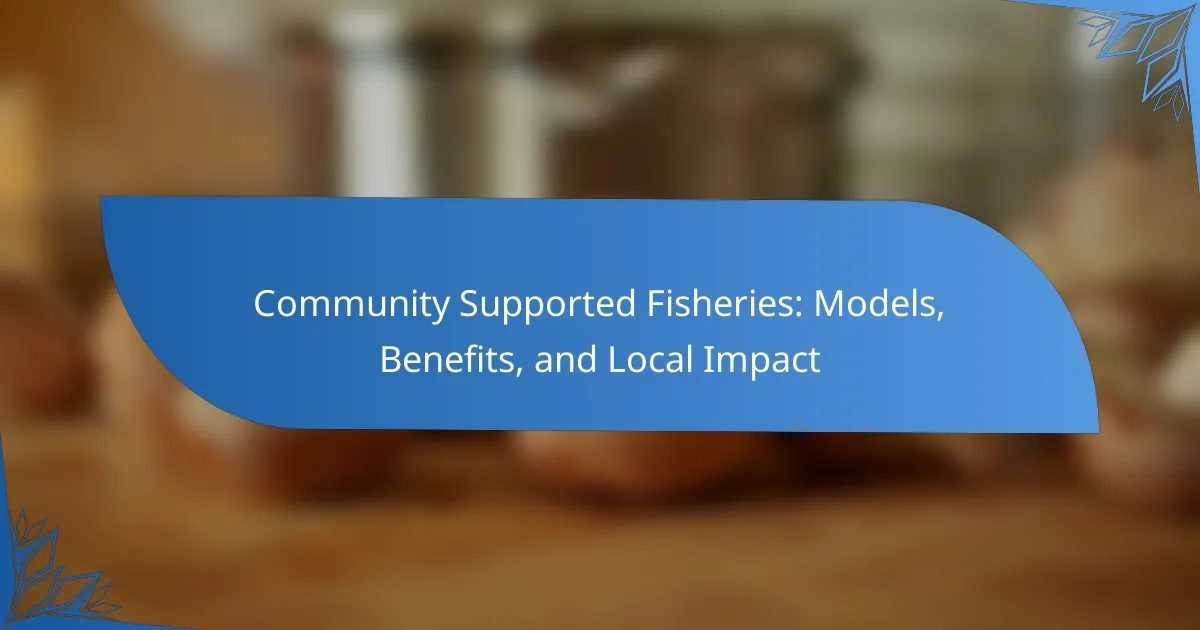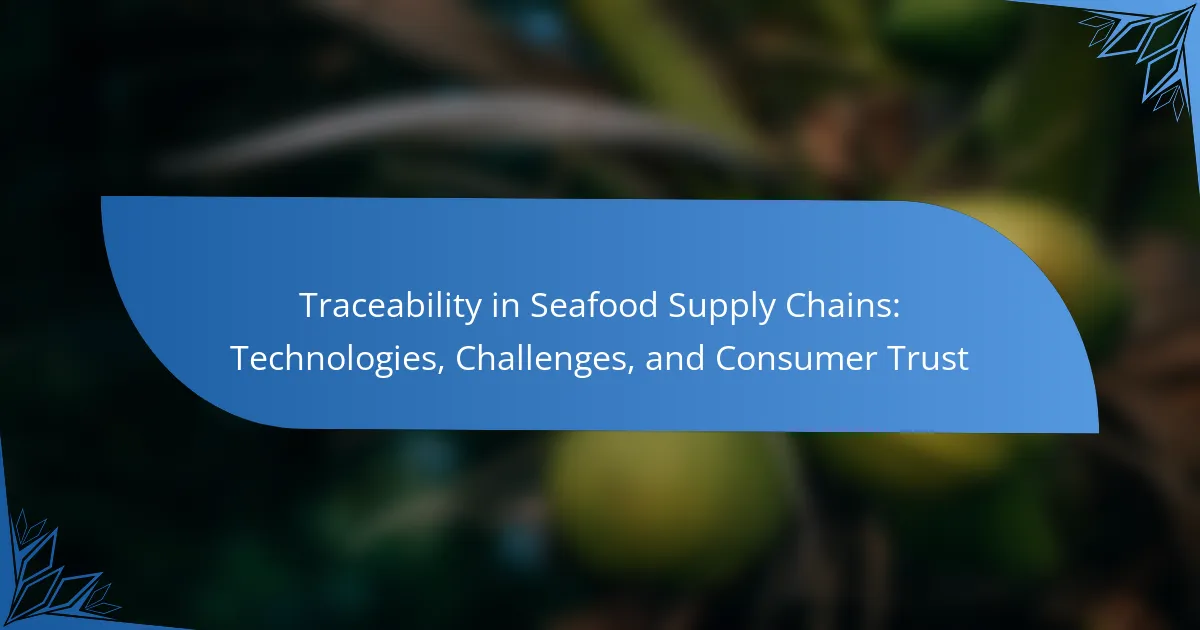
What are Bycatch Reduction Strategies?
Bycatch reduction strategies are methods aimed at minimizing the unintentional capture of non-target species during fishing. These strategies include the use of specialized gear, such as selective nets and escape devices. They also involve modifications to fishing practices, like changing the timing or location of fishing activities. Research shows that implementing these strategies can significantly decrease bycatch rates. For instance, studies have demonstrated that using turtle excluder devices in shrimp trawls can reduce sea turtle bycatch by over 90%. Bycatch reduction strategies not only protect marine biodiversity but also enhance the sustainability of fisheries.
Why are Bycatch Reduction Strategies important in fisheries?
Bycatch reduction strategies are important in fisheries because they minimize the unintended capture of non-target species. This reduction helps preserve marine biodiversity and maintains ecosystem balance. Bycatch can include endangered species, which are crucial for ecological health. Implementing these strategies can lead to sustainable fishing practices. Studies show that effective bycatch reduction can improve fishery yields over time. For instance, the use of specialized nets has reduced bycatch rates by up to 60% in some fisheries. Additionally, these strategies can enhance the economic viability of fisheries by ensuring compliance with regulations. Overall, bycatch reduction is essential for sustainable fisheries management and conservation efforts.
What impact does bycatch have on marine ecosystems?
Bycatch significantly impacts marine ecosystems by disrupting species populations and altering community structures. When non-target species are caught, it can lead to declines in their populations. This affects predator-prey relationships within the ecosystem. For example, the decline of a key species can have cascading effects on other marine life. Bycatch can also result in the loss of biodiversity, which is crucial for ecosystem resilience. The National Oceanic and Atmospheric Administration (NOAA) estimates that millions of fish and other marine animals are caught as bycatch annually. This statistic underscores the scale of the issue and its potential long-term effects on marine ecosystems.
How do Bycatch Reduction Strategies contribute to sustainable fishing?
Bycatch reduction strategies contribute to sustainable fishing by minimizing the capture of non-target species. These strategies include the use of specialized nets and gear designed to allow unwanted species to escape. They also involve implementing best practices and regulations that promote selective fishing methods. Research indicates that effective bycatch reduction can lead to healthier marine ecosystems. For instance, a study by Kelleher (2005) found that implementing such strategies can reduce bycatch by up to 80% in certain fisheries. This reduction helps maintain biodiversity and supports the long-term viability of fish populations. Sustainable fishing practices ultimately benefit both the environment and fishing communities.
What types of Bycatch Reduction Technologies exist?
Bycatch Reduction Technologies (BRTs) include various methods designed to minimize the unintended capture of non-target species in fishing. Common types of BRTs are escape devices, selective gear modifications, and behavioral deterrents. Escape devices allow non-target species to exit fishing gear, reducing bycatch. Selective gear modifications, such as using larger mesh sizes, enable smaller or unwanted species to escape. Behavioral deterrents, like acoustic devices, discourage non-target species from approaching fishing gear. Research shows that these technologies can significantly reduce bycatch rates, enhancing sustainable fishing practices. For example, the use of turtle excluder devices in shrimp trawls has been shown to reduce sea turtle bycatch by up to 97%.
How do selective fishing gear and practices reduce bycatch?
Selective fishing gear and practices reduce bycatch by targeting specific species while minimizing the capture of non-target species. This is achieved through the design of gear that allows unwanted species to escape. For example, turtle excluder devices in shrimp trawls permit sea turtles to exit while retaining shrimp. Additionally, using circle hooks in longline fishing decreases the likelihood of catching non-target fish. Research indicates that these methods can lead to significant reductions in bycatch rates, sometimes by over 50%. Implementing these selective practices enhances sustainable fishing and protects marine biodiversity.
What role do electronic monitoring systems play in bycatch reduction?
Electronic monitoring systems play a crucial role in bycatch reduction by providing real-time data on fishing activities. These systems use cameras and sensors to monitor catch composition and fishing practices. They help ensure compliance with regulations by documenting the species caught and discarded. Studies have shown that vessels using electronic monitoring report lower bycatch rates compared to those without. For example, a study by the National Oceanic and Atmospheric Administration found that electronic monitoring improved bycatch data accuracy by 30%. This data aids in making informed management decisions to reduce bycatch effectively. Overall, electronic monitoring enhances transparency and accountability in fisheries.
How effective are Bycatch Reduction Strategies?
Bycatch reduction strategies are generally effective in minimizing unintended catch during fishing. Various technologies, such as bycatch reduction devices and selective fishing gear, have shown significant success. For instance, studies indicate that certain devices can reduce bycatch by over 50%. Specific case studies demonstrate that implementing these strategies leads to healthier fish populations and ecosystems. Research published in the journal “Fisheries Research” highlights the positive impacts of these strategies on both target and non-target species. Overall, bycatch reduction strategies contribute to sustainable fishing practices and biodiversity conservation.
What metrics are used to measure the effectiveness of these strategies?
Metrics used to measure the effectiveness of bycatch reduction strategies include bycatch rates, species composition, and survival rates. Bycatch rates quantify the number of non-target species caught relative to target species. Species composition assesses the diversity of species captured, indicating the impact of strategies on various marine populations. Survival rates measure the percentage of released bycatch that survives post-release, reflecting the success of mitigation techniques. Studies often use these metrics to evaluate and compare the performance of different strategies in real-world scenarios. For example, a study by Hall et al. (2000) in “Marine Policy” highlights the importance of these metrics in assessing the efficacy of bycatch reduction technologies.
How do Bycatch Reduction Strategies vary in effectiveness across different fisheries?
Bycatch reduction strategies vary in effectiveness across different fisheries due to factors such as gear type, target species, and environmental conditions. For instance, in trawl fisheries, modifications like bycatch reduction devices can significantly lower bycatch rates. Research indicates that these devices can reduce bycatch by up to 50% in certain shrimp fisheries. In contrast, gillnet fisheries often face challenges with bycatch due to the nature of the gear, which can entangle a wide range of species. Studies show that implementing acoustic deterrents can reduce bycatch in these fisheries by approximately 30%. Additionally, the effectiveness of strategies can be influenced by local regulations and the level of compliance among fishers. Overall, the context of each fishery plays a crucial role in determining the success of bycatch reduction strategies.
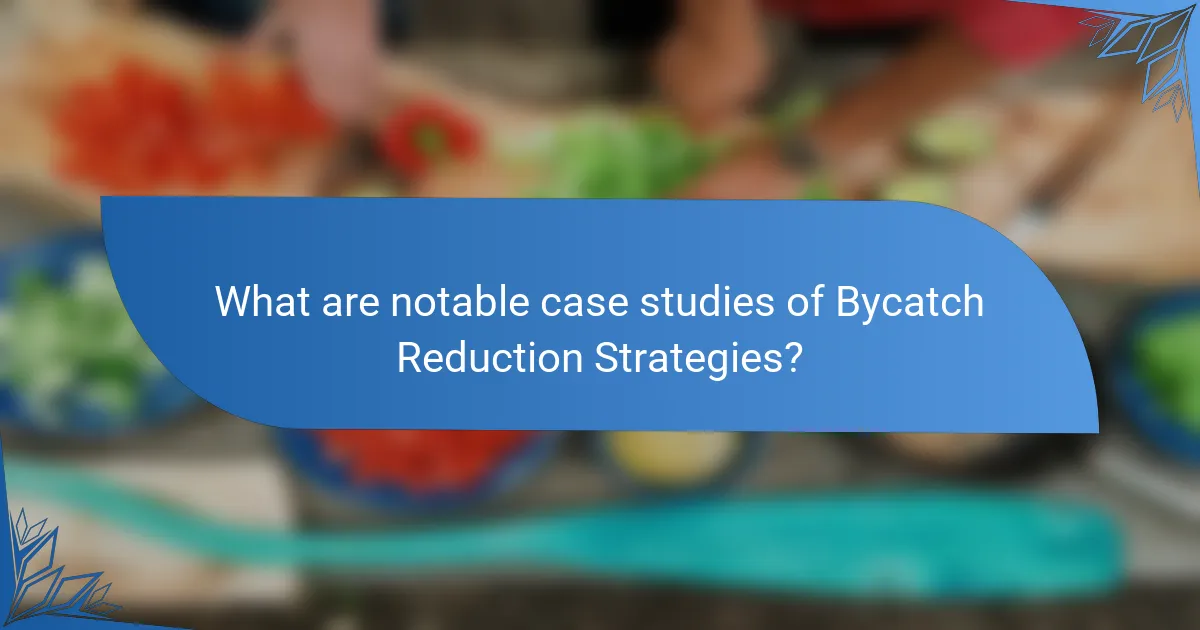
What are notable case studies of Bycatch Reduction Strategies?
Notable case studies of bycatch reduction strategies include the use of turtle excluder devices (TEDs) in shrimp trawl fisheries. TEDs have significantly reduced sea turtle bycatch by allowing them to escape from nets. In the Gulf of Mexico, the implementation of TEDs resulted in a 97% reduction in turtle captures. Another case study involves the use of bycatch reduction devices (BRDs) in Australian prawn fisheries. BRDs have led to a 50% reduction in bycatch species like juvenile fish. Additionally, the use of circle hooks in longline fisheries has decreased the bycatch of seabirds and non-target fish. Studies show that circle hooks can reduce seabird bycatch by over 80%. These case studies demonstrate the effectiveness of targeted technologies in minimizing bycatch in various fisheries.
What successful examples of Bycatch Reduction Strategies can be highlighted?
Successful examples of bycatch reduction strategies include the use of turtle excluder devices (TEDs) in shrimp trawling. TEDs allow sea turtles to escape while retaining shrimp. Their implementation has significantly decreased turtle bycatch, with reports indicating a reduction of up to 97% in some fisheries.
Another example is the use of bycatch reduction devices (BRDs) in gillnets. BRDs are designed to allow non-target species to escape. Studies show that these devices can reduce bycatch by more than 50%.
The use of acoustic deterrents is also noteworthy. These devices emit sounds to deter marine mammals from fishing gear. Research indicates that their use can decrease bycatch rates significantly.
Lastly, the implementation of seasonal closures in certain fisheries has proven effective. By closing areas during critical times, the bycatch of vulnerable species can be minimized. For instance, the Gulf of Mexico’s closure during the spawning season has led to a notable decrease in bycatch of certain fish species.
How did specific technologies lead to reduced bycatch in these case studies?
Specific technologies reduced bycatch in case studies through innovative design and implementation. By using selective fishing gear, such as circle hooks and modified nets, unwanted species were less likely to be captured. Technologies like acoustic deterrents helped keep non-target species away from fishing areas. Additionally, real-time monitoring systems provided data to adjust fishing practices dynamically. Case studies demonstrated that these technologies led to a significant decrease in bycatch rates. For instance, the use of paired tangle nets resulted in up to a 50% reduction in bycatch of certain species. This evidence shows that targeted technological interventions can effectively minimize bycatch in various fishing operations.
What lessons were learned from these successful implementations?
Successful implementations of bycatch reduction strategies revealed several key lessons. First, collaboration among stakeholders significantly enhances effectiveness. Case studies demonstrate that fishermen, scientists, and policymakers working together achieve better results. Second, adapting technologies to local conditions proves crucial. For instance, modifying gear to fit specific fisheries increases bycatch reduction rates. Third, continuous monitoring and data collection are essential. Programs that incorporate real-time data show improved compliance and effectiveness. Lastly, educating fishermen about new technologies fosters acceptance and utilization. Research indicates that training programs lead to higher adoption rates of bycatch reduction methods.
What challenges exist in implementing Bycatch Reduction Strategies?
Implementing Bycatch Reduction Strategies faces several challenges. One major challenge is the economic impact on fisheries. Fishermen may resist adopting new technologies due to potential costs. Additionally, the effectiveness of these strategies can vary by region and species. This variability complicates widespread implementation. Regulatory frameworks can also pose obstacles. Inconsistent policies across jurisdictions may hinder cooperation among fishermen. Furthermore, there is often a lack of research on the best practices for specific fisheries. Without adequate data, developing effective strategies becomes difficult. Lastly, the need for training and education adds another layer of complexity. Fishermen must understand and effectively use new technologies to reduce bycatch.
What are the economic barriers to adopting these strategies?
The economic barriers to adopting bycatch reduction strategies include high initial costs and ongoing operational expenses. Many fishing operators face significant financial constraints that limit their ability to invest in new technologies. For instance, advanced gear modifications can cost thousands of dollars upfront. Additionally, the return on investment may not be immediate, discouraging adoption.
Research shows that small-scale fishers are particularly affected by these economic barriers. According to a study by the Food and Agriculture Organization, small fishers often lack access to credit or financial support. This limits their ability to purchase effective bycatch reduction technologies.
Furthermore, market demand for sustainably sourced seafood can be inconsistent. This uncertainty can lead to reluctance in changing established practices. Economic incentives, such as subsidies or grants, may be necessary to alleviate these barriers and promote the adoption of bycatch reduction strategies.
How do regulatory frameworks impact the effectiveness of Bycatch Reduction Strategies?
Regulatory frameworks significantly influence the effectiveness of bycatch reduction strategies. They establish guidelines and limits for fishing practices. These regulations can mandate the use of specific technologies designed to minimize bycatch. For example, laws may require the installation of bycatch reduction devices in fishing gear. Compliance with regulations can lead to reduced bycatch rates, as evidenced by studies showing lower bycatch in regulated fisheries. Furthermore, regulatory frameworks can enhance monitoring and enforcement, ensuring that bycatch reduction measures are implemented effectively. In contrast, weak or poorly enforced regulations can lead to ineffective strategies and high bycatch levels. Thus, the strength and enforcement of regulatory frameworks directly correlate with the success of bycatch reduction initiatives.
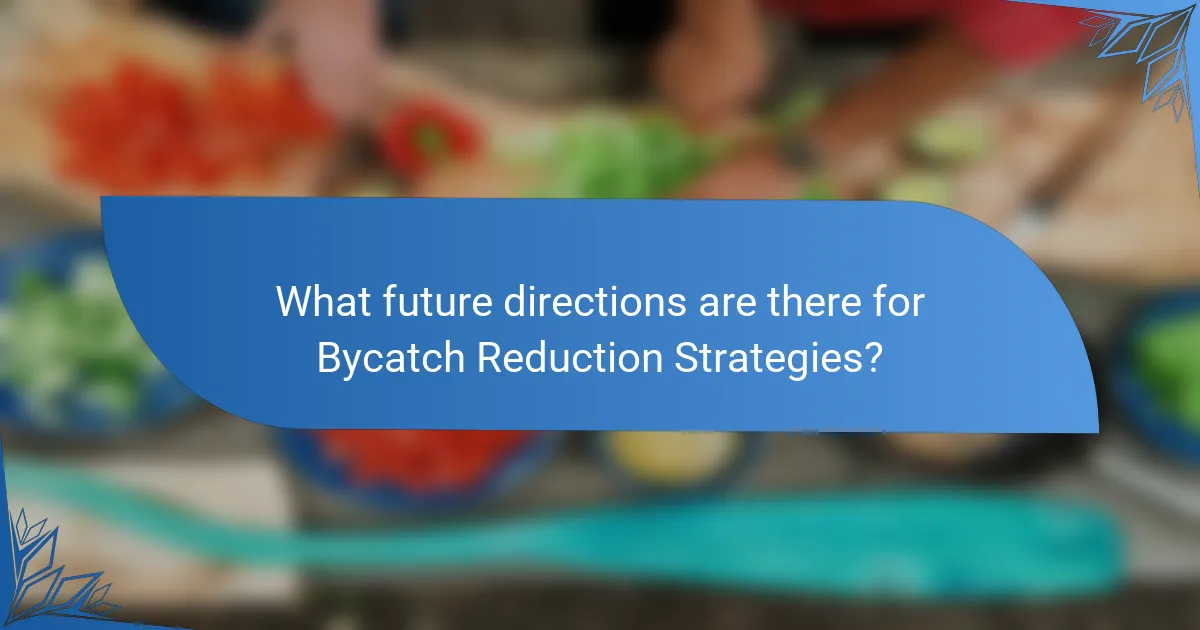
What future directions are there for Bycatch Reduction Strategies?
Future directions for bycatch reduction strategies include the development of advanced technologies, such as selective fishing gear and electronic monitoring systems. These innovations aim to minimize the capture of non-target species. Research indicates that using devices like bycatch reduction devices (BRDs) can significantly decrease bycatch rates. Additionally, implementing real-time data collection can enhance decision-making in fishing practices. Policy frameworks are also evolving to support sustainable fishing and incentivize bycatch reduction. Collaborative efforts among stakeholders, including fishers and conservationists, are crucial for effective strategy implementation. Studies show that integrating ecosystem-based management can lead to more holistic approaches in bycatch reduction. Overall, the future of bycatch reduction strategies relies on technology, policy, and collaboration.
How can innovation drive improvements in Bycatch Reduction Technologies?
Innovation can drive improvements in Bycatch Reduction Technologies by introducing new methods and tools. Advanced materials can enhance the design of fishing gear, making it more selective. For instance, biodegradable nets reduce environmental impact while minimizing bycatch. Smart technology, such as sensors and cameras, can monitor fish populations in real-time. This allows for adaptive fishing strategies that target specific species. Data analytics can improve decision-making processes for fishers. Research shows that innovative gear modifications can reduce bycatch by over 50%. These advancements demonstrate that innovation is crucial for sustainable fishing practices.
What role do stakeholders play in advancing bycatch reduction efforts?
Stakeholders play a critical role in advancing bycatch reduction efforts. They include fishers, conservationists, policymakers, and researchers. Fishers provide practical insights into fishing practices and challenges. Conservationists advocate for sustainable practices and raise awareness about bycatch impacts. Policymakers create regulations that promote bycatch reduction technologies. Researchers develop innovative solutions to minimize bycatch. Collaboration among these stakeholders leads to comprehensive strategies. For example, the collaboration between fishers and scientists has resulted in the development of selective fishing gear. This gear significantly reduces bycatch while maintaining target fish populations. Effective communication among stakeholders enhances the implementation of bycatch reduction initiatives.
What best practices should be followed for effective Bycatch Reduction?
Implementing bycatch reduction devices is crucial for effective bycatch reduction. These devices, such as turtle excluder devices, help prevent the capture of non-target species. Utilizing selective fishing gear also enhances bycatch management. For instance, circle hooks reduce bycatch of seabirds and non-target fish.
Training fishers on bycatch reduction techniques is essential. Education increases awareness of the ecological impact of bycatch. Monitoring and reporting bycatch data can inform better practices. Accurate data helps in assessing the effectiveness of implemented strategies.
Collaborating with stakeholders, including researchers and conservation groups, fosters innovation in bycatch reduction. Joint efforts can lead to the development of new technologies and strategies. Adopting seasonal closures and area restrictions can also minimize bycatch during critical periods. These practices contribute to healthier marine ecosystems and sustainable fishing practices.
How can fishermen adopt and adapt Bycatch Reduction Strategies in their operations?
Fishermen can adopt and adapt Bycatch Reduction Strategies by implementing specific technologies and practices. They can use selective gear, such as circle hooks and escape panels, to minimize unwanted catch. Training programs can educate fishermen on the best practices for reducing bycatch. Data collection and monitoring can help assess the effectiveness of these strategies. Collaboration with scientists and conservation groups can lead to better solutions. Research indicates that these methods can significantly reduce bycatch rates, improving sustainability. For instance, a study by the National Oceanic and Atmospheric Administration found that using bycatch reduction devices decreased bycatch by over 30% in certain fisheries.
What resources are available for learning about Bycatch Reduction Strategies?
Resources for learning about Bycatch Reduction Strategies include academic journals, government reports, and online courses. Academic journals like “Fisheries Research” publish peer-reviewed studies on bycatch reduction methods. Government reports from agencies such as NOAA provide guidelines and data on effective strategies. Online platforms like Coursera and edX offer courses focused on sustainable fishing practices. Additionally, organizations like the World Wildlife Fund (WWF) provide educational materials and case studies. These resources collectively enhance understanding of bycatch reduction techniques and their implementation.
Bycatch Reduction Strategies are methods designed to minimize the unintended capture of non-target species in fishing, utilizing technologies such as selective gear and escape devices. This article explores the importance of these strategies for marine biodiversity and sustainable fisheries, highlighting their effectiveness through various case studies. Key topics include the impact of bycatch on ecosystems, the role of electronic monitoring systems, and the challenges faced in implementing these strategies. Additionally, it addresses the economic barriers and regulatory frameworks that influence their success while providing insights into future directions and best practices for adoption.
